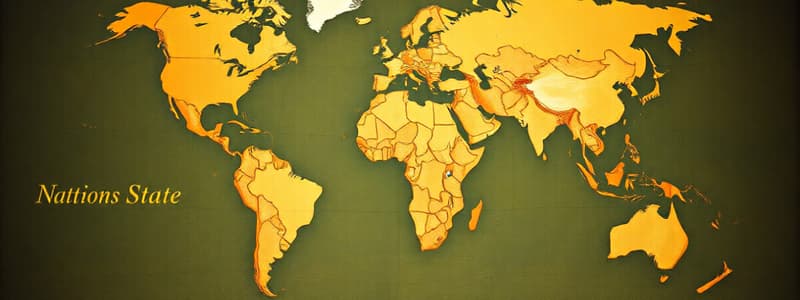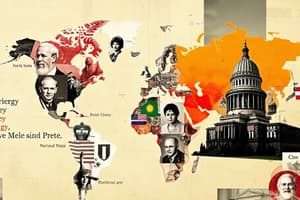Podcast
Questions and Answers
Which of the following is the most accurate description of the relationship between internationalization and globalization?
Which of the following is the most accurate description of the relationship between internationalization and globalization?
- Internationalization is a major part of globalization; it focuses primarily on governmental ties. Globalization encompasses a multitude of connections and interactions that cannot be reduced to the ties between governments. (correct)
- They are equivalent, referring to deepening interactions between states.
- Internationalization encompasses a multitude of connections that cannot be reduced to ties between governments and is a major part of globalization.
- Globalization is a facet of internationalization, focusing primarily on governmental ties.
According to Claudio and Abinales (2018), what are the key attributes that define world politics today?
According to Claudio and Abinales (2018), what are the key attributes that define world politics today?
- There are independent states, diplomacy facilitates state interaction, international organizations assist these interactions, and these organizations can evolve independently. (correct)
- States are interdependent and require common governance, international organizations are nonexistent, and meetings between states do not occur.
- States exist in isolation, international organizations dictate state actions, and diplomacy is obsolete.
- States are governed by international organizations, diplomacy is handled by the United Nations, and task-specific agencies lack autonomy.
What distinguishes a 'nation' from a 'state'?
What distinguishes a 'nation' from a 'state'?
- A nation refers to a country and its government, while a state is an 'imagined community'.
- A state refers to a country and its government, while a nation is an 'imagined community'. (correct)
- A state is an imagined community, while a nation has defined territorial boundaries.
- A state lacks a government and sovereignty, while a nation possesses these attributes intrinsically.
Which of the following best describes the concept of sovereignty in the context of a state?
Which of the following best describes the concept of sovereignty in the context of a state?
What is the significance of Benedict Anderson's description of a nation as an 'imagined community'?
What is the significance of Benedict Anderson's description of a nation as an 'imagined community'?
Which statement accurately represents the relationship between nations and states?
Which statement accurately represents the relationship between nations and states?
What key principle is associated with the Treaty of Westphalia?
What key principle is associated with the Treaty of Westphalia?
How did Napoleon Bonaparte challenge the existing European order?
How did Napoleon Bonaparte challenge the existing European order?
What was the main goal of the Concert of Europe?
What was the main goal of the Concert of Europe?
Which of the following best describes the Metternich system?
Which of the following best describes the Metternich system?
How did Immanuel Kant view the international system?
How did Immanuel Kant view the international system?
What contribution did Jeremy Bentham make to the concept of international relations?
What contribution did Jeremy Bentham make to the concept of international relations?
What was Giuseppe Mazzini's perspective on nationalism and internationalism?
What was Giuseppe Mazzini's perspective on nationalism and internationalism?
What was Woodrow Wilson's vision for the world's nations?
What was Woodrow Wilson's vision for the world's nations?
What role did the League of Nations play in the history of internationalism?
What role did the League of Nations play in the history of internationalism?
According to Karl Marx, what was the primary division in the world?
According to Karl Marx, what was the primary division in the world?
What did Karl Marx and Friedrich Engels believe about nationalism?
What did Karl Marx and Friedrich Engels believe about nationalism?
What was the purpose of the Communist International (Comintern)?
What was the purpose of the Communist International (Comintern)?
Why did some states fear the Comintern?
Why did some states fear the Comintern?
What event marked the practical disappearance of communist internationalism?
What event marked the practical disappearance of communist internationalism?
Flashcards
Attribute of Today's Global System
Attribute of Today's Global System
Countries/states that are independent and govern themselves.
Attribute of Today's Global System
Attribute of Today's Global System
Countries interact with each other through diplomacy.
Attribute of Today's Global System
Attribute of Today's Global System
World politics today has international organizations, like the UN.
Attribute of Today's Global System
Attribute of Today's Global System
Signup and view all the flashcards
State
State
Signup and view all the flashcards
State Attribute
State Attribute
Signup and view all the flashcards
State Attribute
State Attribute
Signup and view all the flashcards
State Attribute
State Attribute
Signup and view all the flashcards
State Attribute
State Attribute
Signup and view all the flashcards
Nation
Nation
Signup and view all the flashcards
Treaty of Westphalia
Treaty of Westphalia
Signup and view all the flashcards
Concert of Europe
Concert of Europe
Signup and view all the flashcards
Internationalism
Internationalism
Signup and view all the flashcards
Liberal Internationalism
Liberal Internationalism
Signup and view all the flashcards
International Law
International Law
Signup and view all the flashcards
Republican government
Republican government
Signup and view all the flashcards
Socialist Internationalism
Socialist Internationalism
Signup and view all the flashcards
Socialist International (SI)
Socialist International (SI)
Signup and view all the flashcards
Communist International (Comintern)
Communist International (Comintern)
Signup and view all the flashcards
Study Notes
- This module uses the 4A's method: Activity, Analysis, Abstraction, and Application.
- Answers should be put in one Word file, and named as: Surname, First name initial, and Chapter number (e.g., Fabillar, F. – Chapter 1).
- Use Arial, font size 12, spacing 1.0, margins 1", orientation Portrait, and size Long.
Learning Objectives
- Identify the attributes of the contemporary global system.
- Differentiate the concepts of state and nation.
- Distinguish the competing conceptions of internationalism.
Attributes of Today’s Global System
- There are countries/states that are independent and govern themselves.
- Countries interact with each other through diplomacy.
- International organizations, like the UN, facilitate these interactions.
- International organizations such as the UN and its agencies like WHO and ILO, take on lives of their own beyond facilitating meetings between states.
Defining Nation-State
- A nation-state is composed of two non-interchangeable terms.
- Not all states are nations, and not all nations are states.
- A state refers to a country and its government.
- A state exercises authority over a specific population, governs a specific territory, has a structure of government, and has sovereignty over its territory.
- Sovereignty refers to internal and external authority.
- Internally, the state has authority and no groups or individuals can ignore the state.
- Externally, state policies are independent of the interventions of other states.
- A nation is an "imagined community" that is limited and rights/responsibilities are for citizens of that nation.
- Nations limit themselves to people with a particular culture, language, and territory.
- Nations strive to become states where a national ideal assumes an organizational form and authority is recognized/accepted by the people.
- Communities which are not states often seek autonomy within their "mother states".
- There are single nations with multiple states, such as Korea which is divided into North and South Korea.
- There are also states with multiple nations like Scotland which belongs to the United Kingdom.
- Nation and state are closely related because nationalism facilitates state formation.
The Interstate System
- The origins of the present-day concept of sovereignty can be traced back to the Treaty of Westphalia (1648).
- The Treaty of Westphalia ended the Thirty Years' War between major powers in Europe.
- The Treaty design included recognizing that treaty signers exercise control over domestic affairs and swear not to meddle.
- The Westphalian system provided stability until Napoleon Bonaparte challenged it.
- Bonaparte aimed to spread the principles of the French Revolution (liberty, equality, fraternity).
- During the Napoleonic Wars (1803-1815), the French implemented the Napoleonic Code, which forbade birth privileges, encouraged freedom of religion, and promoted meritocracy.
- Anglo and Prussian armies defeated Napoleon in the Battle of Waterloo in 1815.
- Royal powers created the Concert of Europe to restore the Westphalian system and maintain monarchical, hereditary/religious privileges.
- The Metternich system (Concert of Europe) sought to restore state sovereignty and lasted from 1815 to 1914.
Internationalism
- The Westphalian and Concert systems divided the world into separate, sovereign entities.
- Internationalism, the desire for cooperation/unity among states and people, comes in different forms.
Liberal Internationalism
- Immanuel Kant argued that a form of world government is necessary to avoid chaos.
- Jeremy Bentham advocated for international law to govern interstate relations.
- Giuseppe Mazzini, an Italian patriot, reconciled nationalism with liberal internationalism.
- Mazzini proposed a custom of free nations to cooperate and create an international system, in which free, independent states would be the basis of an equally free, cooperative international system.
- Woodrow Wilson forwarded self-determination and advocated for the League of Nations.
- The League of Nations aimed for conciliation and arbitration to prevent war but the US Senate did not allow the US to join the League
- The League was unable to prevent World War II.
- The Axis Powers and their ultra-nationalism eclipsed internationalism during WWII
- The League gave birth to task-specific international organizations like the WHO and ILO.
- The League's principles would re-assert themselves in the creation of the United Nations in 1946.
Socialist Internationalism
- Karl Marx differed because he dit not believe in nationalism.
- Marx focused on economic equality and divided the world into classes.
- The capitalist class refers to owners of factories, companies, and other means of production.
- The proletariat class refers to those who work for the capitalists.
- Friedrich Engels believed that the proletariat has no nation and that the workers of the world should unite.
- Marx died in 1883, but The Socialist International (SI) was founded in 1889, and it initiated Labor Day and International Women's Day.
- The SI collapsed during World War I.
- Czar Nicholas II was overthrown during the Russian Revolution of 1917.
- Vladimir Lenin and the Bolshevik Party created the Union of Soviet Socialist Republics (USSR).
- The Bolsheviks led revolutions across the world, using terror if necessary.
- Lenin established the Communist International (Comintern) in 1919 to direct Communist parties.
- Joseph Stalin dissolved the Comintern in 1943 to appease his allies.
- Stalin later re-established it as the Communist Information Bureau (Cominform).
- Communist internationalism practically disappeared, with the collapse of the Soviet Union in 1991.
- Liberal internationalism became ascendant, with the rise of the United Nations.
Studying That Suits You
Use AI to generate personalized quizzes and flashcards to suit your learning preferences.




